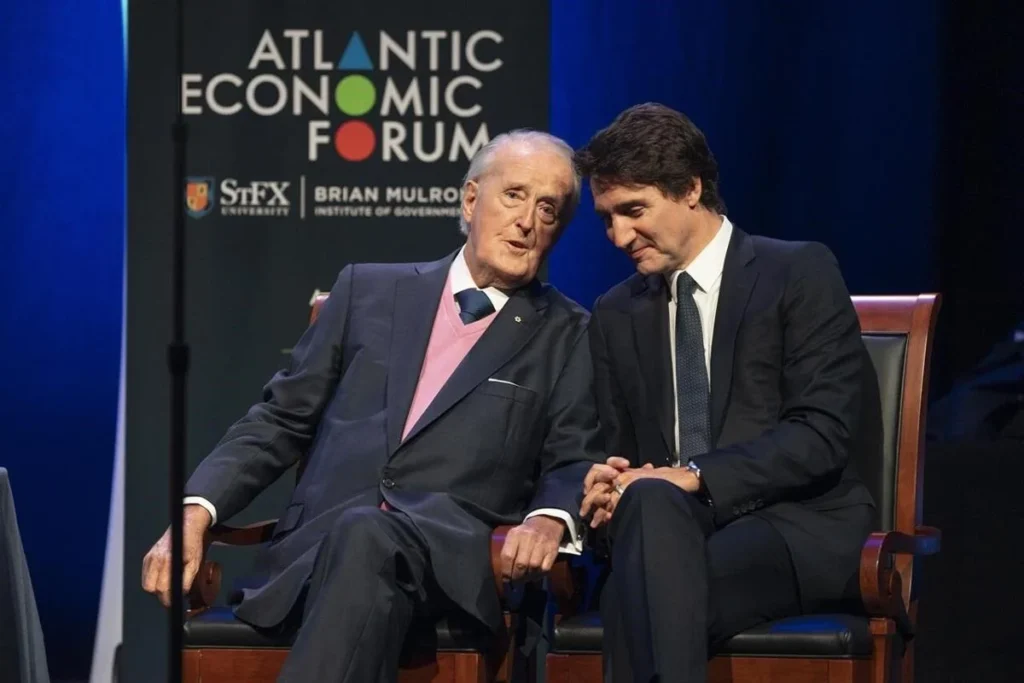To me, the Toronto Public Library is an “essential service” since I borrow so many books. This is hardly surprising when my father and my stepfather each ran public library systems in Toronto a few decades back.
The TPL has been the victim of a ransomware attack for over a month, with no backup system online or even inside each branch. Unless you know the Dewey Decimal system by heart, you are out of luck.
So, I read two books this week from other sources. I have a pile of books I inherited, plus there are free books online, so I chose two non-fiction books about Canadian politics, economics and history – one from 1966 and the other from 1970.
First up was a copy of Donald Creighton’s 1970 history Canada’s First Century, which was in the piles of books I inherited from my mother.
My understanding of pre-1960s Canadian history is uneven, like for choosing who was our best Prime Minister with any real insight, rather than conventional wisdom or recent surveys. Usually MacKenzie King, Laurier or MacDonald come out on top as best PM. An aggregate ranking on Wikipedia lists them in that order, with Pierre Trudeau in fourth.
Creighton’s history is good for my purposes, as it is a pretty conventional history of politics and economics from 1867 to 1967 – without the social cultural or “identity politics” obsessions of recent years. Readers under 30 would likely despise this history.
Creighton was a prominent historian and known to be anti-Liberal – in this book, that descriptor applies most to the remaining period after Diefenbaker. There was no mention of the Avro Arrow, only of the Bomarc missile controversy, which to me was a major oversight. However, there are now a number of good books on Diefenbaker and the rivalry with Pearson om the 1960s that are far better reading.
Creighton was nearly 70 when he wrote this work, and his views of the events of the 60s were the worst part of the book. Historians should likely not pass judgement on events unless they are at least a decade in the past.
MacDonald comes out well in Creighton’s telling, though I certainly need to read a more recent biography about him. I will likely pass over Creighton’s in favour of Richard Gwyn’s 2011 version.
King is certainly our most successful Prime Minister in terms of time in office and number of elections won. King had a PhD from Harvard and had been a successful business consultant in the US (1911-19) before returning to Canada. However, Creighton’s biography predates later revelations about our bachelor PM being a weirdo who attended séances, was fixated on his dead mother, and various other peccadillos that became common knowledge with the publication of King’s diaries long after 1970.
King certainly was a master at winning power and holding onto it, but like Justin Trudeau or Paul Martin, he also made promises of social reforms that were delayed or never delivered at all.
I was always puzzled that King was so willing to take a minor role in the major decisions about fighting WW2, and that some of the decisions he made, like sending troops to defend Hong Kong, were often questionable. Creighton explains this in terms of King essentially being a continentalist and Canadian nationalist, not wanting Canada to end up tethered to formal structures that drew us deeper into the Commonwealth and Britain itself. Apparently, King was not popular with Canadian troops in Italy, where my father fought, while Churchill was loved.
R.B. Bennett’s brief term early in the Depression is treated favourably, and King borrowed or continued with some of Bennett’s ideas when he returned to power, though many of King’s promises regarding the social safety net weren’t implemented until Pearson.
Louis St. Laurent’s star as PM has been rising in recent years, but I saw little in Creighton’s book to justify this, and as an economic nationalist, I remain horrified by what American born C. D. Howe did under St. Laurent to sell out Canada to American economic interests.
In describing Pearson’s time in power, Creighton mentioned a book I had not heard of – “A Choice for Canada: Independence or Colonial Status” written by Walter Gordon in 1966, after Gordon had quit as Pearson’s first Finance Minister. This was the other book I read taking me back to the 1960s, but with a totally different viewpoint than Creighton.
Likely, most people reading this who aren’t yet confined to a nursing home have never heard of Walter Gordon. He was the voice, or father, of English Canadian economic nationalism from the late 1950s until his death in 1987, particularly due to his chairing the 1955-7 Royal Commission on Canada’s Economic Prospects.
One of the first things I noticed when reading A Choice for Canada was that I did not see one mention of Indigenous people in the entire book when describing Canadian society and issues. Current university students would disapprove and find him racist, though in other respects he seems progressive for the times, in noting that Canada and Canadians were not just English or French.
What I found remarkable about the book was how much was accomplished by the Pearson government in its first few years, and that many of the other policies Gordon mentions or advocated were put in place by Pearson, Trudeau or later governments. This includes things we take for granted, such as having bank deposits insured.
A Choice For Canada deals with foreign ownership and the balance of payments in detail. It made me appreciate how much has changed, and how little has changed since 1966 – and how much the Pearson government did in its 5 years. I think Pearson is our best PM, not Laurier – and I need to read more on MacDonald.
The title of the book is a little misleading, as only 3 of the 8 main chapters really deal with Canadian economic sovereignty (6, 7 & 8). The early chapters are more of an overview of things such as the role of francophones and bilingualism, the social safety net and education, financial institutions, and other areas of policy really unrelated to colonialism, but where Gordon puts forth his views.
The key sections deal with the balance of payments (trade and inflows of money in and out of Canada), the increasing levels of foreign investment in Canada, and takeovers, mostly from the US but also from Britain. He included a number of tables detailing the Canadian economy post-WW2, plus a long list of foreign takeovers.
Gordon seemed particularly concerned with Canadian control over natural resources, and while education is a key area of interest for him in Canada’s development, little or nothing is said about new or infant industries like computers, aerospace, defense, pharmaceuticals or plastics.
Perhaps these infant industries were to be covered in his advocacy for the Canada Development Corporation (CDC). This was an idea for a Crown corporation which would invest in companies and hold shares – something like a sovereign wealth fund. This is similar to how governments had already created CN Rail, Air Canada and Polysar (a major chemical company, which was once featured on the back of our $5 bills).
Ultimately the government did create the CDC, and 49% of the shares were held by the public. Other than taking over control of Polysar, it ended up being the dumping ground for government investments or takeovers in failing businesses or industries, such as coal mining or steel in Atlantic Canada. Mulroney dismantled and sold off CDC in 1986, as part of a wave of neoliberal or Thatcherite privatizations.
Outside of Quebec, pensions funds, including the Canada Pension Plan Investment Board (CPPIB), have essentially taken the place of CDC. The worry is, however, that too much of their investments are outside of Canada – instead of providing domestic capital desperately needed to advance our own industries and businesses.
One of the big differences between discussions of the economy today and back in the 1960s is that the Bretton Woods Agreement was still in place, so the balance of payments was often a major concern of both Canadian and American governments. Canada’s dollar was essentially fixed, and the US was still on the gold standard and its dollar was fixed against other currencies at an overvalued rate that typically meant large trade deficits.
Gordon provides a detailed analysis, which includes the problems Canada had under Diefenbaker that led to our dollar being devalued to 92.5 cents US, which was considered scandalously low at the time. Our dollar had been above par for most of the 1950s. Unlike most other countries, Canada actually ran a large trade deficit with the US, and as Finance Minister, Gordon had to get exemptions or adjustments for Canada from the Americans, to prevent or limit their policies from hurting us.
I am of that near extinct species, the economic nationalist – though we have seen “protectionism” rising lately in the US under Trump and Biden. In Canada, I have yet to detect any real resurgence.
But this is where Gordon’s 1966 book shined for me most. He explains the problems of increased foreign ownership in detail and on several levels.
On one level, namely the balance of payments, having high foreign ownership means an outflow of profits, dividends and interest payments in return for a one-time transfer of money to Canada (although often foreign buyers have been able to borrow money from our own banks). This is sort of like if you sold off your house, car and furniture and paid rent instead. In the long run, we are poorer.
A key problem for Gordon is that foreign investment usually ends up with wholly owned Canadian subsidiaries, which is worse than if many shares are still sold in Canada for us to invest in. Canadians are left with few potential investments that earn the same high returns as equity in businesses located here. We still have this problem in that the Toronto Stock Exchange (TSX) is heavily dependent on resource industries (gold, oil, potash, etc.) and in financials (banks and insurance) while lacking in manufacturing and particularly high technology.
I doubt that few people have bothered to read A Choice for Canada in recent decades, given it is hard to find. Even a search of Amazon for Walter Gordon only brings up one item for sale, the 1999 book “Walter Gordon and the Rise of Canadian Nationalism” – that I hadn’t even heard of.
The book is full of economic statistics, and the long list of takeovers is staggering. Labatt Breweries was actually taken over by an American firm around 1964. I never knew this as a teen, and was deluded in thinking it was 100% Canadian. Other than Moosehead, nearly all Canadian breweries of any size are foreign owned. This reminds me of the 2007 book Why Mexicans Don’t Drink Molson.
But this is the problem – it is hard to have a rich and prosperous country (that is not mainly dependent on natural resources for exports) without having great domestically run and headquartered companies.
If I went to the US and asked for the name of something made in Korea, Japan, Germany, or even Italy, surely the Americans could rattle off a few brand names. But if you asked for a Canadian brand name, what would you get – Canada Dry?
Frankly, it is time for Canadians to revive economic nationalism and for our governments to try to ensure that in new and growing “infant” industries, small and medium sized Canadian companies don’t get gobbled up before they can grow into multi-nationals.
Canada’s GDP per capita is dropping, our dollar is around 74 cents (when 92 cents was once a scandal), our record on productivity is terrible, and projections of our future growth for the next few decades come in at the bottom of the 30 or so OECD countries.
In a world of AI and robotics, we will lag even farther behind. We need to do things differently. Our policy of high immigration since 1990 is likely a factor in our poor performance. We cannot support population growth that is overwhelmingly urbanized by relying on natural resources, and we must rethink what we should and should not be doing. Reviving economic nationalism should be part of the debate, including looking back to the wisdom found in Walter Gordon’s writings, and those of the people and programs he influenced.
Editor’s note: This piece was originally published on Brian Graff’s Substack. Subscribe to it here: https://briangraff.substack.com/
All content on this website is copyrighted, and cannot be republished or reproduced without permission.
Share this article!




The truth does not fear investigation.
You can help support Dominion Review!
Dominion Review is entirely funded by readers. I am proud to publish hard-hitting columns and in-depth journalism with no paywall, no government grants, and no deference to political correctness and prevailing orthodoxies. If you appreciate this publication and want to help it grow and provide novel and dissenting perspectives to more Canadians, consider subscribing on Patreon for $5/month.
- Riley Donovan, editor